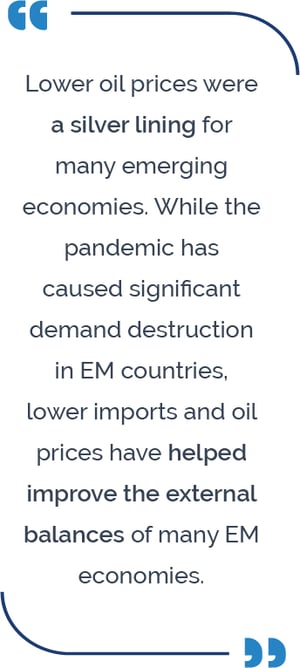In May, you noted that emerging markets (EM) were facing a mix of bright spots and risks. How has that mix played out?
EM equities pulled off their strongest quarter of the past 11 years, rallying 18.1% for the quarter and 31.2% since their March 23 low (though they are still down about 10% for the year).[1] As we suspected, the Fed’s zero interest rate policy and “whatever it takes” approach to restore market calm proved to be bright spots for EM. The Federal Reserve’s aggressive action unleashed animal spirits and dollar liquidity globally, which helped emerging market equities, currencies and debt. Emerging economies also dodged anticipated worst-case outcomes such as sovereign debt defaults and currency crises, fueling the rally in EM assets. The rally in EM assets was especially impressive given the significant negative news flow during the quarter. Global COVID-19 cases surged past the 10 million mark, with Brazil, Russia and India ranking in the top five in number of cases, and Brazil ranking second in the total number of deaths after the United States. Additionally, several countries saw their credit ratings downgraded.
 Lower oil prices, another factor we highlighted in May, were also a silver lining for many emerging economies. While the pandemic has caused significant demand destruction in EM countries, lower imports and oil prices have helped improve the external balances of many EM economies. Lower demand has also kept inflation—a perennial EM concern—at bay, giving policymakers more room to maneuver.
Lower oil prices, another factor we highlighted in May, were also a silver lining for many emerging economies. While the pandemic has caused significant demand destruction in EM countries, lower imports and oil prices have helped improve the external balances of many EM economies. Lower demand has also kept inflation—a perennial EM concern—at bay, giving policymakers more room to maneuver.
What factors could help or hurt EM equities from here?
We are optimistic that additional stimulus measures from the US and European Union may be forthcoming. This could include yield curve control, fiscal spending, negative interest rates or more quantitative easing. Such measures could potentially weaken the dollar and support EM equities. Economic data coming out of the US and other developed economies has been surprisingly positive, which should continue to aid growth in EM economies. China’s economy has been staging a strong recovery driven by growth in industrial production, fixed-asset investment in property and infrastructure, and consumption of goods (now back to pre-crisis trend growth). China’s export and property sectors have been much more resilient than expected, which we see continuing. We also expect China’s monetary easing to continue to support sectors that have not participated in the recovery, to counter deflationary pressures, and to catch up with global central banks, especially the Fed. Capital reforms in China have been accelerating since the beginning of the year, which should benefit domestic Chinese capital markets longer term.
On the other hand, COVID-19 cases are still rising globally, (especially in large economies including the US, India and Brazil) and a successful vaccine is uncertain despite encouraging developments. US-China tensions seem to have reached a crescendo, jeopardizing the Phase 1 trade deal and further trade negotiations. Several emerging markets face slowing growth, high fiscal debt burdens and limited buffers to withstand domestic and exogenous shocks. Public sector debt could continue to increase in some EM countries as public spending is used to fight rising unemployment. This could hurt EM currencies and fuel inflation.
What’s your investment approach in this uncertain environment?
Regardless of market conditions, our investment style is a long-term, concentrated, high-conviction, low-turnover, benchmark-agnostic approach backed by deep private-equity type research and diligence. We believe that in the short to medium term, EM equities can be driven by macro factors that do not discriminate between the “micro.” In macro melt-ups, the rising tide can lift all boats, and low-quality stocks can rally hard. In macro meltdowns, high-quality stocks can sell off, and babies can get thrown out with the bathwater. In our view, many global investors are “tourists” in EM and are there only for the beta; we believe this creates opportunities for us to generate alpha.
Given our beliefs, we consider the second quarter a rare investment opportunity. We increased our positions in high-quality Indian financials, many of which were trading at valuations last seen during the global financial crisis. We increased our position in a leading Latin American online travel company, which was trading near the cash level on its balance sheet. We also increased our positions in some transitioning quality stocks, including a Chinese security solutions provider, a Brazilian enterprise resource planning software company, a Brazilian transportation operator, and a high-quality South African bank.
[1] Source: Bloomberg; performance for MSCI Emerging Markets Index as of 6/30/2020.
MALR025777
This is not an offer of, or a solicitation of an offer for, any investment strategy or product. Any investment that has the possibility for profits also has the possibility of losses.
Performance data shown represents past performance and is no guarantee of, and not necessarily indicative of, future results.
Market conditions are extremely fluid and change frequently.
This blog post is provided for informational purposes only and should not be construed as investment advice. Any opinions or forecasts contained herein reflect the
subjective judgments and assumptions of the authors only and do not necessarily reflect the views of Loomis, Sayles & Company, L.P. Information, including
that obtained from outside sources, is believed to be correct, but Loomis Sayles cannot guarantee its accuracy. This material cannot be copied, reproduced or
redistributed without authorization. This information is subject to change at any time without notice.




